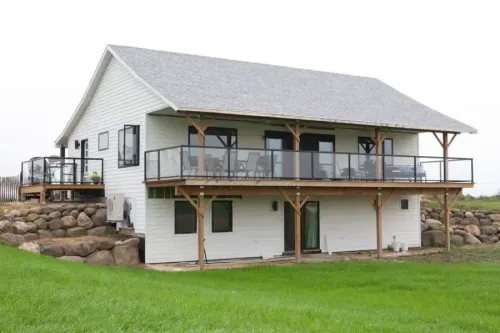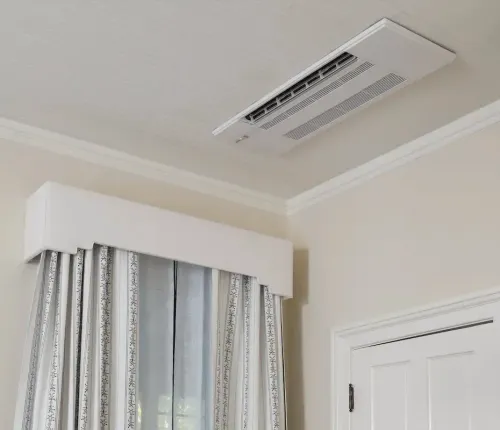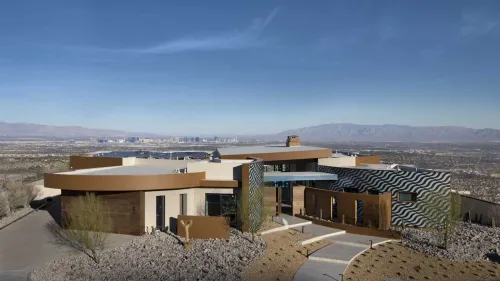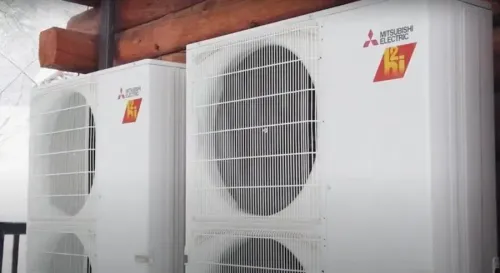Project Location: New Canaan, Connecticut
Completion Date: November 2014
Challenge
Creating more effective zoning and freeing a large home from its dependence on oil heatSolution
Mitsubishi Electric Variable Refrigerant Flow (VRF) technologyResult
A sustainable lifestyle and significant zoning capabilities
Megin and Adam Wolfman lived in their 19-year-old home in New Canaan, Connecticut, for two years before wanting an updated HVAC system. Instead of treating the situation as a hassle, the couple treated it as an opportunity – a chance to explore their carbon footprint and think about more effective zoning. A Variable Refrigerant Flow (VRF) system from Mitsubishi Electric offered them the next-generation technology they desired, alongside a host of benefits.
Adam said, “We recognized that we were nearing the end of life for our HVAC system due to some components’ age and maintenance issues related to the cooling side – leaks in the attic and basement.” As Megin explained, “We lacked peace of mind.”
The couple began thinking about what kind of system they wanted to have in terms of reliable operation free of air leaks and their home’s environmental impact. “We were interested in getting rid of our dependence on oil – in terms of both maintenance and being environmentally conscious. Once we committed to moving off oil, the incentives totally changed. The idea of a high-efficiency system that utilized the existing ductwork became really appealing,” said Megin.
As the couple explored technologies like VRF and geothermal, they discovered that VRF meant “the promise of quiet, efficient condensers,” said Megin. They also found that the technology would offer heating in cold temperatures – a surprise, said Megin, since “we’d written off air source heat pumps as only appropriate for southern climates.” The ability to go with both VRF as a technology and ducted indoor units as a style was particularly compelling. “I’d only seen ductless ones around here. It was great to learn we could use our existing extensive ducted infrastructure. We also had a preference for a ducted system aesthetically,” said Megin.
The couple liked Mitsubishi Electric VRF because “it was the only system available in the U.S. that could leverage our existing infrastructure.” Additionally, as Adam explained, they received great support: “Our HVAC contractor worked in partnership with the local Mitsubishi Electric sales rep, looking at a variety of options, including commercial grade products. We felt our specific needs were being addressed.”
That HVAC contractor was Eastern Mechanical Services, Inc. (Ems), Danbury, Connecticut. Ted Huizinga, Ems’ president, said, “The Wolfmans wanted to be energy-independent, so we looked into photovoltaic solar panels to power their electric needs. Mitsubishi Electric, obviously, then fit the bill in terms of heating and cooling their house – even in a cold, Connecticut climate. The Mitsubishi Electric equipment totally satisfies the heat gains and losses of their house.”
Huizinga knows Mitsubishi Electric products well because he installed them in Ems’ own offices. “When I was doing the design work in my office building, I was going to put in a hydro air system, and for the cooling side I was going to have Mitsubishi Electric. But then I thought, wait a minute, CITY MULTI® is 100 percent efficient at 13 degrees above zero Fahrenheit outside ambient temperature. I don’t need a boiler! I can cool and heat my building without it. Moreover, Mitsubishi Electric had an easier installation than Daikin, which I was also considering at the time. It’s worked very well for us.”
For the Wolfmans, Huizinga liked that Mitsubishi Electric would bring “a low noise level to the table. This home is in a quiet residential neighborhood, so noise was a factor.” Taylor Cannavaro, at the time doing system design and sales at Ems, and currently a Mitsubishi Inside Sales Application Specialist at Homans Associates, Wilmington, Massachusetts, added that Mitsubishi Electric technology also offered zoning capabilities. He said, “With this technology, the Wolfmans are able to manage their zones more independently. If there are certain areas of the house that they hardly use, they can condition those zones just a little, or not at all.” Megin agreed that zoning is key for her family: “We’re a family of four, so we liked the ability to use only four of our eight zones on a regular basis. We could keep the other four active, but dialed way back.”
With the decision made, a challenging but ultimately successful installation began. Cannavaro said, “The Wolfmans didn’t want to see any of the line sets, so we had to get creative. We put three air handlers downstairs and the other five in the attic, then worked the lin esets in, keeping them all hidden by finding chase ways.” The team also sealed and cleaned the ducts, and “insulated the daylights out of their roofing system,” said Huizinga.
Since installation, the Wolfmans have been enjoying their new, sustainability-minded space. As planned, they’ve even installed a solar field. Megin said, “Our decision was about role modeling environmental awareness to our kids – who were four and six at the time – and the future generation. Our house had a pretty big carbon footprint, so this was also about reducing our individual dependence on fossil fuels. We’re excited by our new carbon footprint, and that we’re pushing the envelope.”
She continued, “It was a prudent decision financially, as well. It feels really great to not have utility bills.”
The Wolfmans also received rebates tied to the Mitsubishi Electric system and other sustainability-minded renovations, like adding insulation. Adam said, “Each stage of the project enabled us to secure some rebates. We were able to factor that into our decision-making.”
Looking back, the couple is pleased with their decision to go with VRF. Adam said, “We set out to consider – from the outset –how we could think about an HVAC solution that might not be mainstream today but will become much more prevalent. This system was the leading edge, the best-in-practice. Think about something like halogen lighting, which our house originally had. Not too long ago, it was the most efficient product out there. Now, you don’t use it. So we thought, if we put in an efficient traditional system, we’ll face immediate obsolescence. Is there potentially something better?” For the Wolfmans, with VRF, there absolutely was.
Project Team
- HVAC Contractor: Eastern Mechanical Services, Inc., Danbury, Connecticut
- Distributor: Homans Associates, Wilmington, Massachusetts
Mitsubishi Electric Equipment Installed
- (3) PUMY S-Series Outdoor Units
- (5) PUZ P-Series Outdoor Units
- (5) PEAD Ceiling-concealed Ducted Indoor Units
- (3) PEFY Ceiling-concealed Ducted Indoor Units
- (5) MHK1 Wireless Wall-mounted Thermostats









